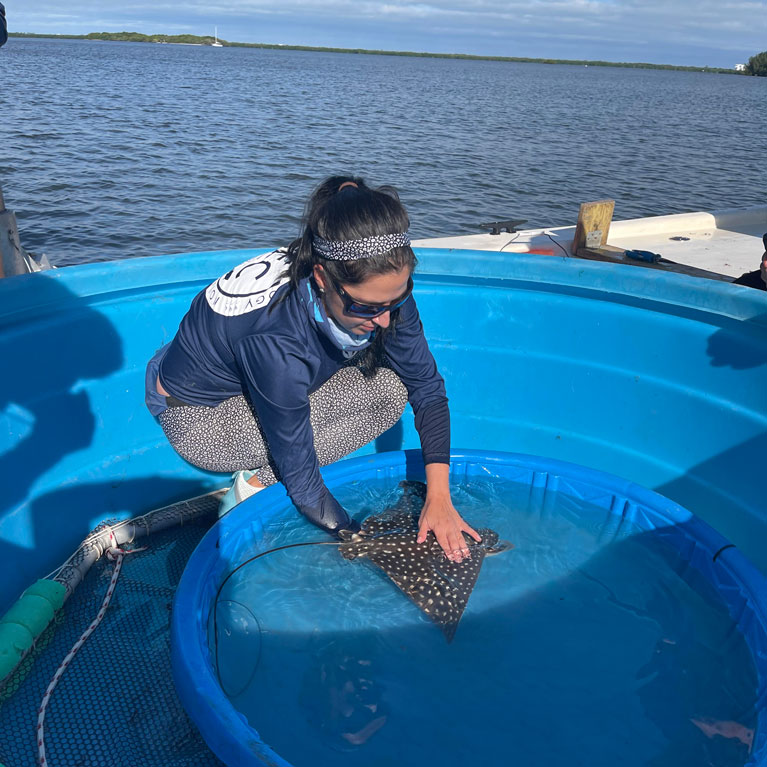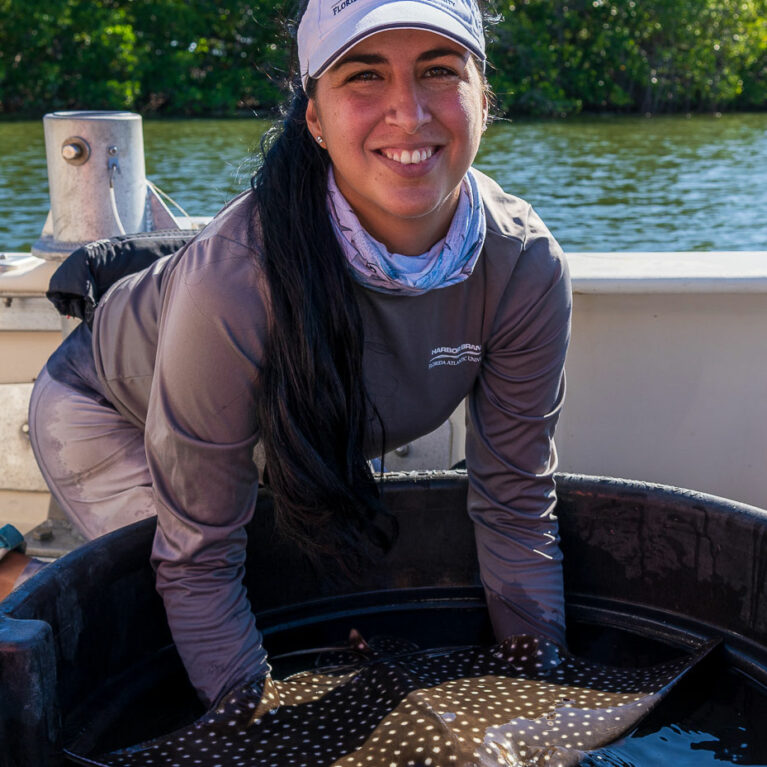Nurseries for Florida’s protected whitespotted eagle ray
In a first project of its kind for North America, Ariadna wants to identify hotspot areas in the Indian River Lagoon and Sarasota Bay, Florida, where young whitespotted eagle rays can be protected until old enough to disperse as adults and thus help to recover their populations. To do this, she will be investigating their fine-scale movement patterns in these areas: how, when and where are they using different regions? This will give Ariadna an idea of core-use areas to complement what we know about adult whitespotted eagle rays.
I grew up on the island of Cuba where I learned how to swim long before I learned how to ride a bicycle. I fondly remember riding on the back of my dad’s bike for our weekend visits to the beach. Every time we went, he struggled to get me out of the water and keep me from bringing home every shell I found. When I was considering a career path, my parents said to me, ‘Make sure you choose something you love. That way you won’t work a day of your life.’ Hearing those words, I knew...




Assessing the nursery potential of Florida's coastal waters for the whitespotted eagle ray (Aetobatus narinari)
The main goal of this project is to assess the potential nursery value of the Indian River Lagoon and Sarasota Bay for Florida’s protected whitespotted eagle ray using acoustic telemetry tracking techniques.
The whitespotted eagle ray is a globally Endangered species that has suffered a significant population decline in the past three decades. Eagle rays give birth to 1–4 pups each year, mature slowly and are susceptible to fishing pressure. To address this population decline, we aim to identify hotspots to reduce threats to young rays and help their populations to recover. This will be the first study of its kind in North America.
In marine ecosystems, eagle rays play a key ecological role; they serve as prey for top predators such as sharks and they themselves prey on marine molluscs and crustaceans. The whitespotted eagle ray Aetobatus narinari is a shell-crushing predator whose strong, plate-like teeth enable it to break open the exoskeletons of invertebrates. It occurs in coastal inshore waters such as bays, estuaries and coral reefs, where fishing pressure is substantial. Such regions include the Gulf of Mexico, Caribbean Sea and the eastern, central and south-eastern Atlantic Ocean along the west coast of Africa. The fact that the species is found at depths from the sea floor to the surface makes it vulnerable to a range of fishing gear throughout the water column, especially inshore gill-nets, which are used intensively throughout most of its range. In the north-western and west-central Atlantic, artisanal fisheries for the whitespotted eagle ray are not well described, but are known to exist in Cuba, Mexico and Venezuela. Eagle rays are vulnerable to intensive fishing effort since they mature late and have low fecundity. As a result, they have suffered significant population declines in the past 30 years and are now considered endangered. Like other cartilaginous fish, they may use nursery habitats to ensure the survival of their young. These are areas where the rays are born and juveniles stay until they reach maturity, and they offer abundant food and protection from predators. For these species, the identification of nursery habitats can help reduce threats to young animals and help populations to recover. Fortunately, the whitespotted eagle ray is protected under the Florida Administrative Code and cannot be harvested, possessed, landed, purchased, sold or exchanged in Florida. Therefore, based on the protection status of this species, identifying nursery habitats in Florida’s coastal waters could have significant conservation implications.
- To assess the residency and fine-scale movements of young rays in the Indian River Lagoon and Sarasota Bay.
- To identify the core use areas and behaviour of young rays to complement previous research on adults.

